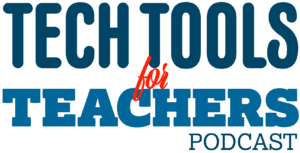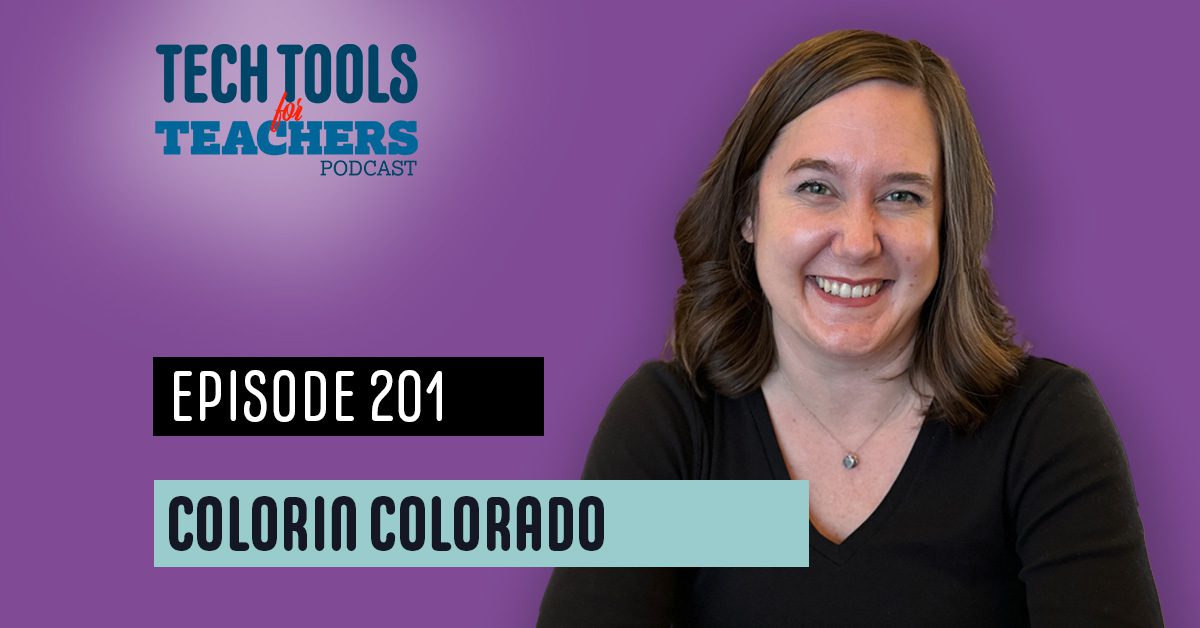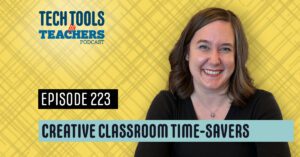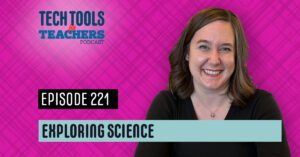[00:00:00] Shanna Martin: Thanks for listening to the Tech Tools for Teachers podcast, where each week we talk about a free piece or two of technology that you can use in your classroom. I’m your host, Shanna Martin. I’m a middle school teacher, technology, and instructional coach for my district.
[00:00:31] Fuzz Martin: And I’m our producer and husband, Fuzz Martin.
And sometimes these intros get a bit rocky.
[00:00:38] Shanna Martin: Oh, wow. Nice. That was so clever. I know. So here we are, January, coldness in good old Wisconsin. And we’re on episode 201, so we’ve gone past the 200 mark. It’s very exciting. And all the things, end of semester, all of the children are now cold and antsy. Yes. But it’s not quite February yet.
So we’re doing okay, we’re still holding on to the holidays. So here we are, season seven.
[00:01:15] Fuzz Martin: Season seven.
[00:01:16] Shanna Martin: Episode
[00:01:16] Fuzz Martin: 201. Episode 201.
[00:01:18] Shanna Martin: And you made a joke about Rocky.
[00:01:21] Fuzz Martin: I did. I did.
[00:01:24] Shanna Martin: Like the Rocky mountains, folks. Yes.
[00:01:27] Fuzz Martin: Like the Rocky mountains, John Denver.
[00:01:30] Shanna Martin: Good job.
[00:01:30] Fuzz Martin: That’s amazing.
[00:01:32] Shanna Martin: So, the site we’re talking about today is called Colorine Colorado, and it is really, really, really helpful if you have English learners in your classroom, or in your building or in your school.
And there’s so many cool resources. So I’m highlighting the things that I think are the most useful, but if you just dig into this website, you are going to find so much helpful information for your students and for your families. My highlights, my top five list, so grade level support for teachers.
So there is all kinds of support for teachers. You can pull up grade level support. Like grade level two students and I’ve got ELs in my classroom and I need to figure out how I’m going to support them and what what’s best for their meeting their needs. And so that’s really helpful. And I’ll kind of walk through all this in the site.
Two, there are parent resources, which are so helpful. And this website can be in either English or Spanish. So you just push a button and the whole website switches from English to Spanish, which is really helpful to help. Those students families, and I give them resources at home. Um, there is professional development for teachers and paras and administrators and all kinds of videos and resources, resource library.
You can sort by audience on the site, which is really cool. So if you, there’s a button that you click, on the right hand side, and when you click it, it will change to be like teacher resources. Click on it, paraprofessional resources, click on it, administrative resources. So there’s so much information depending on what the audience is.
You can click on it and the site will sort it for you, which I think is really helpful, especially when you’re digging through all these resources. And then the last one, there’s a huge resource library of books and articles and videos and all kinds of stuff, which is super awesome, and helping and meet all of these kids needs.
So they know what’s going on and to be able to feel a part of your classroom. So, on the site itself, You will see it’s kind of laid out just straight across the bar, across the tabs. Like there’s ELL basics, school support, teaching ELLs, for families, books and authors, videos. And then there’s that audience button I was talking about.
And you choose which audience you are. There’s even actually a button for librarians as well. And then there’s the resource library. But I’m going to show you the ELL basics. Again, there’s so much information. I’m just going to highlight a couple of the cool things that are in here. But it like, for starters.
New to teaching ELLs, ELLs in your classroom, it kind of gives you a little background if it’s your first year. Here’s a Spanish classroom glossary, um, that would help just basic phrases and things like that to support your kids. When they’re learning things, there’s a guide in there and click on the little guide and each button kind of takes you down to, there’s, PDFs that you’re able to kind of go through.
But if you’re in the basic guide, helpful words and phrases in Spanish, common expressions, like, hello, how are you? Very good classroom expressions. And then things like bathroom and pencil and pen and some of those things where if you haven’t had. Spanish is a class ever, kind of some background information, but I think of also using that for labeling your classroom for students and also helping your students who are English speaking learn some of those basic phrases so that way they can communicate with their classmates both ways as well.
I took Two years of Spanish in high school, so I can do my colors in my days of the week, but when it comes to supporting my students as I have middle schoolers, actually, it’s kind of fun because I have them teach me new words as well, so that way I can learn as they’re learning as well. They have featured articles, so like, as you’re a new teacher, you can scroll through and it’ll give you, like, some video information and some book lists just for students.
Beginners, and research, and recommendations, and social media, and you just keep scrolling through this list of all of these resources, and you can pick and choose what would meet your needs as a, teacher having not having ELLs in your classroom before or Introducing that to your students as well.
They have special populations under EL basics. They have policy and research. They have information by state. So all of that’s resources, just like the basic information. They have it all nicely laid out for you, which is really cool. If you look under school support, they have, different options for like college readiness for ELLs versus.
events during the school year. Like how do you handle those things and how do you label them? And what does that look like? And back to school resources and parent teacher conferences. I mean, I just, there’s so many cool things. And I also appreciate them. There’s also. Videos in there of teachers who have experience communicating with parents and making sure that you’re effectively making sure those kids are supported in your classrooms as well, which is really cool.
There’s just so many resources. Yeah. Yeah, they also have like teaching ELL. So then you can go through like language and vocabulary and literacy instruction and, and alignment with common core and technology. And we’ve done an episode before. I believe it was last season where I had audio, where there was like basic conversations and audio with students, that they could use as a resource library.
And that also, those sites could also easily be used with like this resource, but also then the students can have, audio and speaking skills that they could practice as well. And so those two sites would be helpful that we talked about. Something when you’re talking, when you’re teaching your EELs in your classroom and finding different ways to support them, especially older students, I think middle school, high school, where they can work independently.
During some time, if it’s built into their day to help support them in the classroom, which is cool under the family’s source resources they have from preschool through school success, to raising bilingual kids, to technology at home, again, libraries and all kinds of resources. They have books and authors that are helpful.
That would be really cool, to go into a diverse book guides and resources. The resources are phenomenal. Like there’s so many in the site and then videos. So they have a whole collection of videos, but authors, the experts, they even have a Facebook live series. They have a PBS show.
[00:07:58] Fuzz Martin: Cool.
[00:07:59] Shanna Martin: We love PBS.
We do. And it’s called Becoming Bilingual. And so it goes through reading rackets and, coaching young readers on how, what being bilingual is like. So there’s resources for that. And again, more support and questions and blogs and all of these things. So, if you have Students in your classroom that are coming in, that are new to your classroom or depending on their level, because, our EL kids have, you know, levels one through four and how they’re like labeled and what they need support in.
This is just a huge resource that is very helpful for teachers, whether they’ve had students before, or if you’re getting new students into your classroom to just have that information, which I think would be really helpful. So check it out,
[00:08:46] Fuzz Martin: check it out.
[00:08:48] Shanna Martin: Color in Colorado, and it has all kinds of things on the site, C O L O R I N C O L O R A D O.
org. So there you go. And again, you can, the site comes in both English and in Spanish. So whatever your needs are. That is available as well.
[00:09:10] Fuzz Martin: They did a very great job on this website of just making the navigation super easy. And every, like, even if you go, you know, to the ELL resources by state and we click on Wisconsin, like even the news changes to a Wisconsin news and such.
So, it’s pretty cool. Yeah, I dig it. They did good work on the website UX on top of everything else, on top of all the great content.
[00:09:39] Shanna Martin: Yes, as well. Awesome. So check it out, check out the resources for your teachers, pass them on to those that could use it, for professional development with your staff, if you’re in charge of that or able to be in charge of that, there might be some, helpful trainings in here that might be good for your students and, or sorry, for your staff.
So just think about it and check it out and see all the resources on Coloring Colorado.
[00:10:00] Fuzz Martin: Cool. Very good.
[00:10:02] Shanna Martin: So there you go. There’s our little chat this week. Thanks for tuning in. This has been the Tech Tools for Teachers podcast. If you ever have any questions, you can find me on Blue Sky, Threads, Facebook, Instagram at Smart in WI.
And if you want to get more information on the links to the technology discussed in this episode, visit smartinwi. com. If you’d like to support the show. Please consider buying me a coffee or two. Visit buymeacoffee. com slash smartinwi or visit smartinwi.com and click on that cute little purple coffee cup.
Your donations help keep the show going. New episodes each week. Thanks for listening. Go educate and innovate.
[00:10:39] Fuzz Martin: The ideas and opinions expressed in this podcast and the smartinwi.com website are those of the author, Shanna Martin, and that of her employer. Prior to using any of the technologies discussed on this podcast, please consult with your employer regulations.
This podcast offers no guarantee that these tools will work for you as described, but we sure hope they do. And we’ll talk to you next time here on the Tech Tools for Teachers podcast.








